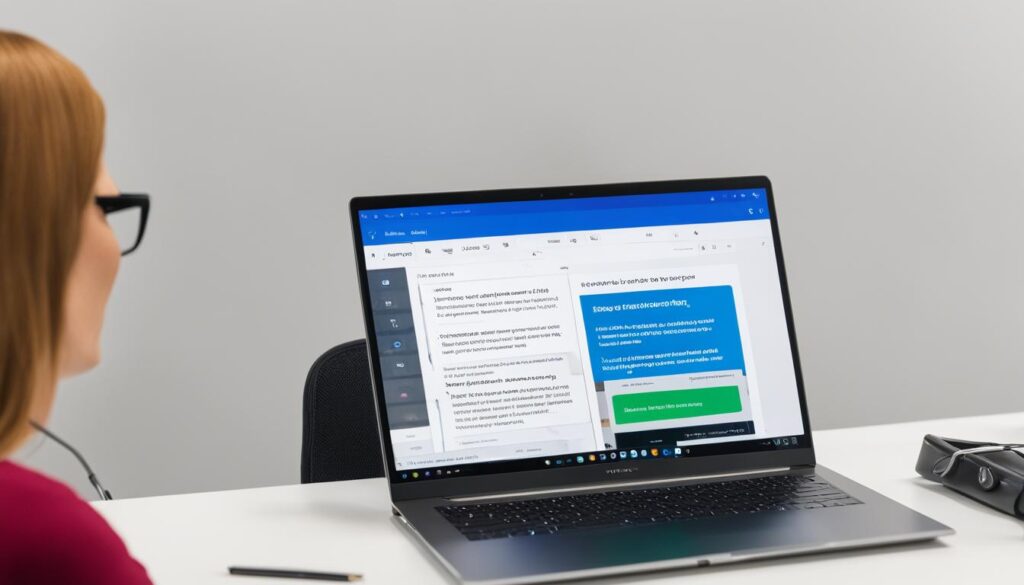Accessiblity testing is the process of making sure that digital products, such as websites and mobile apps, meet required standards and guidelines to make them usable for all internet users. The main goal is to create an online environment that is inclusive and allows individuals with disabilities to fully utilize digital tools and content.
Accessibility testing is not only a moral obligation but also a legal requirement and a business opportunity. It promotes equality by providing equal opportunities in education, development, healthcare, and beyond. It improves the quality and user experience of digital products, making them more enjoyable, intuitive, and efficient for all users. Furthermore, accessibility testing refines brand image, demonstrating a commitment to inclusivity and social responsibility.
Key Takeaways:
- Accessibility testing ensures that digital products are usable by everyone, including individuals with disabilities.
- It is a legal requirement and promotes equality and inclusivity.
- Accessibility testing improves the quality, user experience, and brand reputation.
- It provides equal opportunities in education, development, healthcare, and beyond.
- Prioritizing accessibility testing is a strategic move to tap into a wider audience and foster inclusivity.
The Significance of Accessibility Testing
In today’s digital age, web accessibility testing plays a vital role in ensuring that websites and digital products are accessible to individuals with disabilities. With approximately 16% of the global population and 26% of the U.S. population having disabilities, prioritizing web accessibility is crucial to provide equal opportunities and a seamless user experience.
Accessibility testing encompasses various aspects, including web accessibility testing, inclusive design testing, and assistive technology testing. By conducting these tests, businesses can promote inclusivity and create digital experiences that cater to diverse user needs.
But why is accessibility testing significant? Let’s explore its key benefits:
- Promoting Inclusivity: Accessibility testing ensures that individuals with disabilities can access and navigate digital products without limitations. It promotes inclusivity and equal participation, allowing everyone to leverage the power of the web.
- Providing Equal Opportunities: By focusing on web accessibility testing, businesses can provide individuals with disabilities the same access to information, services, and opportunities as their non-disabled peers.
- Improving User Experience: Accessibility testing helps identify and address usability barriers, ensuring a seamless experience for all users. It enhances the overall usability, usability, and satisfaction of digital products.
- Enhancing Brand Reputation: Prioritizing inclusivity through accessibility testing sends a strong message to customers and stakeholders. It demonstrates a commitment to social responsibility, which can enhance brand reputation and attract a wider audience.
Accessibility testing is not only beneficial from a moral and ethical standpoint but also presents a significant business opportunity. By adopting inclusive design principles and leveraging assistive technologies, businesses can tap into an underserved market segment while creating positive user experiences.
Web accessibility testing, inclusive design testing, and assistive technology testing are essential components of the accessibility testing process. Let’s delve deeper into each of them:
Web Accessibility Testing
Web accessibility testing involves evaluating websites and digital products against recognized accessibility standards such as the Web Content Accessibility Guidelines (WCAG). It focuses on ensuring that websites are perceivable, operable, understandable, and robust for all users.
Inclusive Design Testing
Inclusive design testing aims to create products that are usable by individuals with diverse abilities and disabilities. It involves considering different user needs from the initial design phase and conducting targeted tests to validate the inclusivity of the product.
Assistive Technology Testing
Assistive technology testing involves evaluating the compatibility of digital products with assistive devices such as screen readers, braille displays, and switch devices. By ensuring compatibility with assistive technologies, products can provide a seamless experience for users with disabilities.
By embracing web accessibility testing, inclusive design testing, and assistive technology testing, businesses can create digital products that are truly accessible and inclusive.
Next, we will explore why accessibility testing matters and its impact on various aspects of user engagement and online experiences.
Why Does Accessibility Testing Matter?
Accessibility testing plays a crucial role in providing a barrier-free digital experience for individuals with disabilities. By removing obstacles, it fosters equality and ensures that everyone has equal opportunities in education, development, healthcare, and beyond.
In addition to promoting inclusivity, accessibility testing also enhances the overall quality and user experience of digital products. By making websites, mobile apps, and software more accessible, it allows for a more enjoyable, intuitive, and efficient user experience for all.
To ensure that digital products meet the necessary accessibility standards, it is important to conduct various types of testing. This includes:
- WCAG Compliance Testing: Evaluating whether a digital product conforms to the Web Content Accessibility Guidelines (WCAG), a globally recognized standard for web accessibility.
- Mobile Accessibility Testing: Testing the accessibility of websites and apps on mobile devices, considering factors such as touch interactions, screen sizes, and device capabilities.
- Usability Testing: Assessing the overall usability and user-friendliness of a digital product, with a focus on accessibility aspects.
By conducting WCAG compliance testing, mobile accessibility testing, and usability testing, organizations can ensure that their digital products are accessible, inclusive, and user-friendly for all individuals, regardless of their abilities.
Benefits of Accessibility Testing
Accessibility testing promotes equality, improves the user experience, and enhances brand reputation.
Accessibility testing brings several benefits to businesses and users alike. Here are some key advantages:
- Promoting Equality: By making digital resources accessible, businesses provide equal opportunities and empower individuals with disabilities to participate fully in the digital world.
- Improving User Experience: Accessible digital products are easier to use, navigate, and interact with, leading to a more enjoyable and seamless user experience for everyone.
- Enhancing Brand Reputation: Prioritizing accessibility testing demonstrates a commitment to inclusivity and social responsibility, enhancing the brand’s reputation and attracting a wider audience.
Overall, accessibility testing is essential for creating an inclusive digital landscape and ensuring that no one is left behind. By embracing accessibility, organizations can create a positive impact, improve user experiences, and build a more equitable and accessible online environment for all.
Which Software Requires Accessibility Testing?
While all types of software should undergo accessibility testing, it is crucial to prioritize testing strategically based on user needs and requirements. By researching the target audience and gathering user data through methods such as surveys, interviews, and analytics, developers and testers can gain valuable insights to guide the accessibility testing process.
Accessibility testing involves the evaluation of software to ensure that it meets the necessary standards and guidelines for accessibility. This includes both automated and manual accessibility testing, as well as conducting comprehensive accessibility audits. The goal is to identify and address any critical design flaws that may hinder the accessibility of software products.
Automated accessibility testing utilizes specialized tools and software that can automatically scan the codebase and user interface to identify potential accessibility issues. This approach is efficient for rapidly identifying common accessibility problems.
Manual accessibility testing involves human testers who analyze software products and assess their accessibility based on guidelines and best practices. This method allows for in-depth testing, evaluation, and validation of accessibility features and interactions.
Additionally, conducting accessibility audits is essential to ensure that software products comply with accessibility standards and regulations. An accessibility audit involves a systematic review of the software to identify areas of improvement and ensure adherence to WCAG guidelines.
By being proactive in addressing accessibility issues and focusing on both automated and manual testing methods, developers can ensure that their software products are accessible to users of all abilities.
Automated accessibility testing is an important step in ensuring that software products are accessible to users of all abilities.
How to Approach Accessibility Testing?
Approaching accessibility testing involves conducting various practical steps. Researching the target audience and understanding their needs, preferences, and usage of the product are crucial for effective testing. Collaborating with representative users or accessibility experts can provide valuable insights and perspectives. Choosing the appropriate accessibility standards, such as the Web Content Accessibility Guidelines (WCAG), and considering other standards like Section 508 or EN 301 549 is essential.
When conducting accessibility testing, it is important to test aspects related to vision disabilities, hearing disabilities, physical disabilities, and specific learning disabilities (SLD) and cognitive impairments. This includes:
- Screen reader testing: Evaluating how well the digital product works with screen readers, which convert text to speech or braille for visually impaired users.
- Keyboard navigation testing: Ensuring that all interactive elements can be accessed and used solely with keyboard input, benefiting users who cannot use a mouse or other pointing devices.
- Color contrast testing: Verifying that the color combinations used in the product meet the WCAG guidelines for sufficient contrast, allowing users with low vision to perceive the content accurately.
- Alt text testing: Checking that all non-text content, such as images, charts, and graphs, have appropriate alternative text descriptions. Alt text is crucial for users who rely on screen readers or have images disabled.
| Testing Aspect | Description |
|---|---|
| Screen reader testing | Evaluates compatibility with assistive technologies that convert text to speech or braille. |
| Keyboard navigation testing | Ensures all interactive elements can be accessed and used with keyboard input only. |
| Color contrast testing | Verifies that color combinations used meet WCAG guidelines for sufficient contrast. |
| Alt text testing | Checks that non-text content has descriptive alternative text for screen reader users. |
By following these steps and thoroughly testing different accessibility aspects, you can create a more inclusive and user-friendly digital product that caters to a diverse audience.
Testing with Empathy and Purpose
When it comes to testing digital products for accessibility, a key approach is to approach it with empathy and purpose. This means utilizing assistive technologies to evaluate the accessibility of websites and applications.
Assistive technologies, such as screen readers and voice-activated assistants, play a critical role in enabling individuals with disabilities to access and navigate online experiences. By using these tools during testing, developers can gain valuable insights into the user experience for people with diverse abilities.
Furthermore, artificial intelligence (AI) technology is advancing rapidly and has the potential to personalize app experiences based on users’ habits and skills. By incorporating AI-driven accessibility features, developers can enhance usability and tailor digital products to the specific needs of individuals with disabilities.
It is essential to ensure that software products are compatible with assistive technologies, making them truly inclusive. Rather than treating accessibility features as external extensions, they should be an integral part of the design and development process.
Cultivating a culture of equal accessibility involves spreading awareness and fostering inclusivity throughout the development process. By prioritizing inclusive design testing and embracing assistive technology testing, developers can create digital products that are accessible to all, regardless of their abilities.

Empathetic Testing for Inclusive Design
Inclusive design testing goes beyond merely meeting accessibility standards. It focuses on understanding the unique needs and challenges faced by individuals with disabilities and finding innovative solutions to optimize their experiences. To achieve this, developers can implement a variety of practices, including:
- Conducting usability testing with individuals with disabilities to gather first-hand feedback and identify pain points.
- Engaging in user research to gain insights into the diverse needs, preferences, and usage patterns of the target audience.
- Collaborating with accessibility experts or users with disabilities to ensure that the product meets their specific requirements.
- Implementing inclusive design principles from the early stages of product development, considering diverse abilities and use cases.
Advancing Accessibility Through Purposeful Testing
By employing assistive technology testing, developers can create digital products that are compatible with the assistive tools used by individuals with disabilities. This involves:
- Conducting screen reader testing to ensure that the content is properly read out and navigable via screen readers.
- Performing keyboard navigation testing to verify that all functionality can be accessed using keyboard strokes alone.
- Performing color contrast testing to ensure that text and graphical elements are easily distinguishable for those with visual impairments.
- Testing the effectiveness of alt text to guarantee that individuals with visual impairments can understand non-text content.
By incorporating these testing practices, developers can proactively identify and address accessibility issues, creating digital products that are truly inclusive and user-friendly for individuals with disabilities.
The Importance of Website Accessibility
Website accessibility is of utmost importance in today’s digital landscape. It ensures that websites are designed and developed in a way that allows all users, regardless of their abilities, to interact with and access them uniformly. By prioritizing website accessibility, businesses can create a more user-friendly experience, tap into a wider audience, and foster inclusivity through inclusive design.
Website accessibility extends beyond the design aspect and encompasses various online services, making it possible for everyone to partake in the digital world. Whether it’s reading news articles, engaging in online shopping, accessing banking services, or interacting with government platforms, website accessibility ensures that every individual can participate seamlessly.
Not only is website accessibility a compliance requirement, but it is also a strategic move for businesses. By embracing inclusive design and prioritizing accessibility, companies can cater to a diverse range of users, providing equal opportunities for all. It goes beyond legal obligations and aligns with the principles of social responsibility.
“Website accessibility is not a luxury, but a necessity. It allows businesses to reach a broader audience while creating an inclusive digital environment for all users.”
Creating a user-friendly experience through website accessibility positively impacts brand reputation and customer satisfaction. It demonstrates a commitment to inclusivity, empathy, and user-centric design. By considering the needs and preferences of all users, businesses can ensure that their websites cater to a wider range of abilities, creating an environment where everyone can interact and engage effectively.
Furthermore, embracing website accessibility is not just about compliance or improving brand image. It also holds tangible benefits for businesses. Accessible websites have improved search engine optimization (SEO), which leads to higher search engine rankings and increased visibility in search results. This visibility attracts more organic traffic, potential customers, and ultimately, more conversions.
Ultimately, website accessibility is a strategic decision that benefits both businesses and users. By prioritizing inclusive design and accessibility testing, businesses can ensure that their online platforms are user-friendly, inclusive, and aligned with accessibility standards. Through website accessibility, businesses can create a digital space where everyone can participate, engage, and connect seamlessly.
What is Accessibility Testing?
Accessibility testing plays a crucial role in ensuring that digital products, including websites, mobile apps, and software, are inclusive and usable by all users. It involves evaluating whether these products meet the necessary accessibility standards and guidelines set by reputable organizations such as the World Wide Web Consortium (W3C) and the Web Content Accessibility Guidelines (WCAG).
The primary focus of accessibility testing is to ensure that individuals with diverse abilities can navigate, perceive, and interact effectively with the digital content provided. By adhering to accessibility standards, developers and testers can evaluate and improve the accessibility of digital products, providing an inclusive experience for all users.
Web accessibility, in particular, plays a vital role in enabling individuals with disabilities to access and utilize digital resources. Accessibility testing helps identify potential barriers to access, such as issues with navigating menus, using assistive technologies, or understanding the content displayed. By addressing these issues, web accessibility testing ensures that everyone can fully benefit from the opportunities and information provided by digital platforms.
By considering the needs and considerations of individuals with disabilities, accessibility testing contributes to the overall usability and effectiveness of digital products. It facilitates an inclusive digital environment that caters to a wider audience. Furthermore, adhering to accessibility standards not only serves the ethical imperative of ensuring equal access but also supports legal compliance and creates positive brand associations.
In the next section, we will explore why accessibility testing is essential and how it impacts various aspects of digital product development.
Why is Accessibility Testing Important?
Accessibility testing plays a crucial role in ensuring inclusivity and equal access to digital platforms for users of all abilities. By conducting thorough accessibility testing, businesses can not only comply with legal requirements and accessibility standards but also enhance the user experience and establish a positive brand image.
One of the key reasons why accessibility testing is important is to ensure legal compliance. By adhering to accessibility regulations such as the Web Content Accessibility Guidelines (WCAG), businesses can avoid legal issues and potential lawsuits, demonstrating their commitment to equal access for all users.
Moreover, prioritizing accessibility testing helps businesses cultivate a positive brand image. When companies proactively invest in creating inclusive digital experiences, they show their dedication to inclusivity and social responsibility. This can significantly enhance their reputation and attract a wider audience of users who value accessibility.
Enhancing the user experience is another significant benefit of accessibility testing. By identifying and addressing barriers that may hinder users with disabilities, businesses can create a more inclusive and user-friendly environment. This leads to higher customer satisfaction, increased engagement, and improved overall user experience.
In addition, accessible websites also enjoy improved search engine optimization (SEO) performance. Search engines prioritize websites that are accessible to all users, making them more likely to rank higher in search results. This can expand the business’s market reach and attract more organic traffic, leading to potential business growth.
Ultimately, accessibility testing is a fundamental aspect of building a digital presence that caters to all users. By ensuring legal compliance, cultivating a positive brand image, enhancing the user experience, and improving SEO, businesses can create a more inclusive and successful online presence.
Key Benefits of Accessibility Testing:
- Ensuring legal compliance with accessibility regulations
- Establishing a positive brand image and social responsibility
- Enhancing the user experience and customer satisfaction
- Improving search engine optimization (SEO) performance
Accessibility Testing Tools
Accessibility testing tools play a crucial role in ensuring that websites and applications are accessible to all users, including those with disabilities. These software applications provide comprehensive testing capabilities, covering various aspects of accessibility to ensure compliance with standards and guidelines. When choosing an accessibility testing tool, it is essential to consider the following key features:
- Comprehensive Testing: The tool should offer a wide range of testing functionalities to assess the accessibility of different components, such as images, forms, navigation, and multimedia content.
- Automation: Automation features streamline the testing process by automatically scanning the code and identifying accessibility issues. This saves time and effort compared to manual testing methods.
- Reporting and Remediation: A good accessibility testing tool should provide detailed reports that highlight the identified accessibility issues and offer guidance on how to fix them. This enables developers to prioritize and remediate the issues effectively.
- Compatibility with Standards: The tool should align with recognized web accessibility standards such as the Web Content Accessibility Guidelines (WCAG) to ensure that the tested websites and applications meet compliance requirements.
- Integration: Integration with development environments and continuous integration (CI) tools allows for seamless integration of accessibility testing into the software development workflow, enabling early detection and prevention of accessibility issues.
By using accessibility testing tools that possess these features, developers can identify and remediate accessibility issues, ensuring that their websites and applications provide an inclusive digital experience. With the right tools in hand, achieving and maintaining accessibility compliance becomes a streamlined and efficient process.

Example: Accessibility Testing Tools Comparison
| Feature | Tool A | Tool B | Tool C |
|---|---|---|---|
| Comprehensive Testing | ✅ | ✅ | ✅ |
| Automation | ✅ | ✅ | ✅ |
| Reporting and Remediation | ✅ | ✅ | ✅ |
| Compatibility with Standards | ✅ | ✅ | ✅ |
| Integration | ✅ | ✅ | ✅ |
Note: The table above provides a high-level comparison of three hypothetical accessibility testing tools. Each tool meets all the essential features required for effective accessibility testing. Actual tool features may vary.
Conclusion
Accessibility testing plays a crucial role in ensuring that digital products are accessible and user-friendly for everyone, particularly individuals with disabilities. By prioritizing accessibility testing, businesses can promote inclusivity, improve the overall user experience, and enhance their brand reputation. It is not only a moral obligation but also a strategic decision that opens up opportunities to tap into a wider audience and create a more empathetic and universally accessible online experience.
Engaging in accessibility testing can be a rewarding and enjoyable experience, as it allows for the development of new skills and perspectives. It enables testers to make a positive impact in the world by breaking down barriers and enabling equal access to digital resources. Moreover, by adhering to accessibility standards, testers can ensure that their digital products comply with legal requirements and demonstrate a commitment to inclusivity and social responsibility.
As the digital landscape continues to evolve, accessibility testing will remain a vital practice for creating a more inclusive and equitable online environment. By embracing accessibility, businesses can not only improve the usability of their products but also gain a competitive edge in the market. So, let us embrace the power of accessibility testing and work towards a future where everyone can access and enjoy the digital world without constraints.
FAQ
What is accessibility testing?
Accessibility testing is the practice of checking if a digital product meets the necessary standards and guidelines to make it easily usable for everyone on the web.
Why is accessibility testing significant?
Accessibility testing ensures that websites and digital products are accessible to individuals with disabilities, promoting inclusivity, equal opportunities, improved user experience, and enhanced brand reputation.
Why does accessibility testing matter?
Accessibility testing allows individuals with disabilities to enjoy the digital experience without barriers, promotes equality, improves the quality and user experience of digital products, and ensures compliance with accessibility standards.
Which software requires accessibility testing?
All software should undergo accessibility testing, including automated accessibility testing, manual accessibility testing, and accessibility audits.
How should one approach accessibility testing?
It is important to research the target audience, collaborate with representative users or accessibility experts, choose appropriate accessibility standards, and test aspects related to vision disabilities, hearing disabilities, physical disabilities, and cognitive impairments.
How can testing be done with empathy and purpose?
Testing with empathy and purpose involves using assistive technologies, considering artificial intelligence (AI) technology, and creating a culture of equal accessibility through awareness and inclusivity in the development process.
Why is website accessibility important?
Website accessibility ensures that all users, irrespective of their abilities, can interact with and access websites uniformly, allowing everyone to partake in the digital world.
What is accessibility testing?
Accessibility testing is the practice of evaluating whether digital products, such as websites, mobile apps, and software, meet accessibility standards and guidelines set by organizations like the World Wide Web Consortium (W3C) and the Web Content Accessibility Guidelines (WCAG).
Why is accessibility testing important?
Accessibility testing ensures inclusivity for all users, helps businesses comply with legal requirements and accessibility standards, creates a positive brand image, improves the user experience, and expands market reach.
What are accessibility testing tools?
Accessibility testing tools are software applications designed to evaluate and ensure that websites and applications are accessible to all users, providing comprehensive testing capabilities and generating detailed reports.









